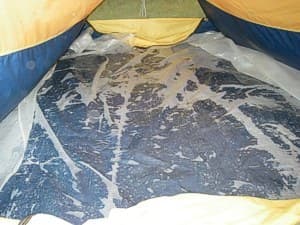Rain-proofing Your Tent
I advise people to put a waterproof plastic groundsheet INSIDE their tent, not under the floor as recommended by tent makers and so-called experts. An interior groundsheet will contain flowing groundwater that floods your tent.

What about using a second groundcloth under the floor to prevent punctures from rocks and sticks? Bad idea because water that is trapped between the tent floor and exterior plastic sheet will be pressure-wicked by body weight into your tent. The effect is similar to pitching the tent on a slab of concrete! Also, a second, exterior groundcloth is just one more thing to carry-more bulk, more weight.
An exterior groundcloth will not discourage tears in a tent floor. Why? Because holes commonly develop like a "green stick break". Example: When you bend a green stick it compresses on the bottom and elongates on top. The break first occurs on the elongation (top) side. Ditto when a sharp stick pokes through your tent floor: As the stick begins to force its way upward through the floor, the undersurface (non-coated side) of the nylon compresses and the upper surface (coated side) elongates. When the elongation becomes great enough, the top coating breaks and the stick pokes through. The solution is to strengthen the elongation surface (top surface), not the compression side. An interior groundcloth does exactly that.
Friends and I discovered this phenomenon years ago when we began using our fragile wood-strip solo canoes in rapids. Adding extra layers of fiberglass to the bottom of our boats added extra weight but little security. Ultimately, we observed that the strips always broke inward-"green stick breaks". We responded by adding a football-shaped reinforcing layer of fiberglass (and later Kevlar) to the inside hull. Problem solved.
The idea to put the groundcloth under the tent started in the 1950's when few tents had floors. If you've ever pitched a floorless tent you know it isn't easy. Squaring the perimeter means moving and re-setting stakes. Campers didn't have the patience for this, so tent makers sewed in floors to make tents easier to pitch, not to keep out water. But any ground water that gets inside a floored tent stays there, and that's why you need an interior groundcloth to keep the flow away from you! Make the groundcloth a foot larger than the tent all around - so it flows well up the side-walls.
Cliff Jacobson is a professional canoe guide and outfitter for the Science Museum of Minnesota, a wilderness canoeing consultant, and the author of more than a dozen top-selling books on camping and canoeing. Visit his website at: www.cliffcanoe.com
Related Articles
This question is from imsealin – they asked how long should a kayak be for sea kayaking, and can it be…
One of the considerations for deciding which type of material you want your kayak to be made from…
I've been busy lately rearranging my cooking essentials: the little tools that I can't do without. Of…
A discussion on the use of a compass from a kayaking standpoint begins with basic compass savvy and then…



